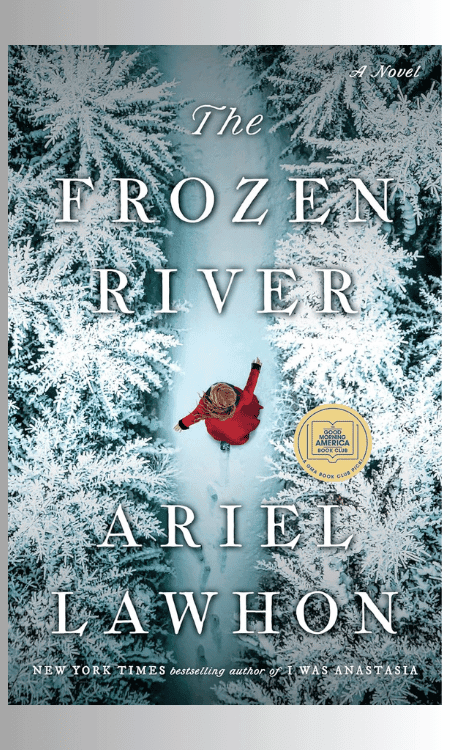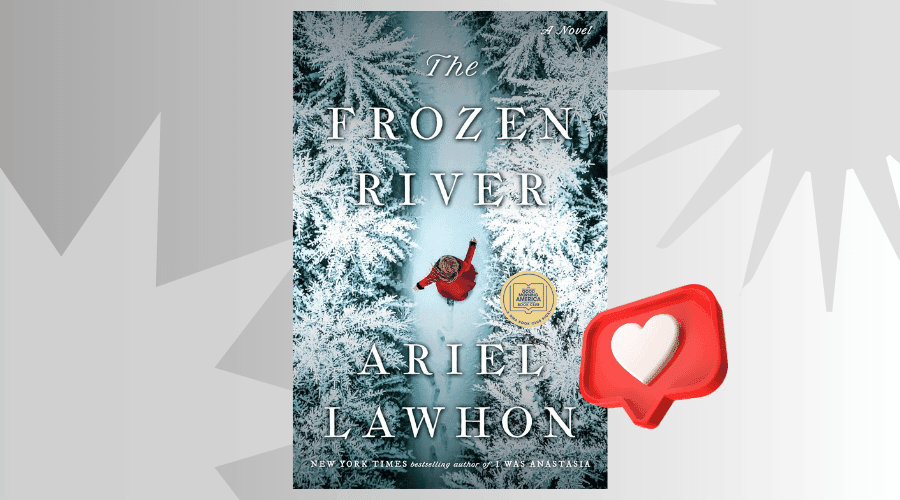The Frozen River by Ariel Lawhon is a gripping historical mystery inspired by the real-life diary of Martha Ballard, an 18th-century midwife and healer. Set in 1789 Maine, the story follows Martha as she investigates the discovery of a man’s frozen body in the Kennebec River. With ties to an alleged rape she documented months earlier, the case uncovers dark secrets within her tight-knit community. Blending fact and fiction, the novel explores themes of justice, power, and the resilience of women in early America, painting a vivid picture of life on the rugged frontier.

| Author | Ariel Lawhon |
| Publication date | December 5, 2023 |
| Goodreads Rating | 4,42 |
| Page count | 432 pages |
| Genres | Historical Fiction, Fiction, Mystery, Historical, Thriller, Mystery Thriller, Adult, Crime |
The Frozen River Summary
Opening: Winter Descends on Hallowell
The novel begins in the frozen landscape of 1789 Maine, where Martha Ballard — midwife, healer, and diarist — moves through her days delivering babies and tending to illnesses across her frontier town. We see the world through her practical gaze, as she documents her labor and the rhythms of life around her. Her diary establishes her role as a keeper of truth long before the legal world will accept women’s voices.
Rebecca Foster’s Trauma
Early in the story, Martha is called to examine Rebecca Foster, who claims she has been violently raped by two powerful men. Martha sees undeniable evidence of the assault — bruising, emotional shock, and torn flesh — and offers comfort while recording every detail. She understands the risk: accusing powerful men can destroy women’s lives. Yet she does not hesitate to believe Rebecca and protect her truth.
Rumors and Patriarchal Doubt
The town’s reaction is swift and cruel. Men whisper that Rebecca lies, women hold their breath in quiet solidarity, and powerful figures close ranks. Martha carries on with her healing work — births, illnesses, deathbeds — but she seethes privately at the injustice of a world that refuses to listen to women. Still, she writes, knowing that ink is power.
A Body in the Frozen River
The quiet of winter shatters when a corpse is pulled from beneath the ice of the Kennebec River. Martha is summoned to examine it; the dead man is identified as Joshua Burgess, rumored to have been involved in Rebecca’s assault. Martha observes signs of struggle — bruising around the throat, torn skin — and concludes it was murder. Once again, she documents everything, sensing that someone wants this death forgotten.
Martha Begins Her Quiet Investigation
As she continues her midwife rounds, Martha gathers information with a careful ear. Villagers reveal pieces of the truth through gossip, fear, silence, and slips of the tongue. Martha begins to see the contours of a conspiracy: Burgess did not fall through the ice — he was silenced. Even as she delivers children and tends the sick, she becomes the town’s unofficial detective, driven not by ambition but by duty.
Rebecca Refuses to Disappear
Despite humiliation and scrutiny, Rebecca demands justice. Town lines harden. The women, quietly, form a protective circle around her, while men dismiss the assault as hysteria. Martha is her anchor, the only person who can validate her suffering publicly. The two women become linked by truth in a world that fears it.
Public Tension and Personal Threats
Anger simmers throughout the community. Doors close a little faster when Martha approaches. Men treat her with strained politeness. She senses danger but remains unflinching, driven by the knowledge that silence would betray every woman she has ever treated. Meanwhile, her marriage remains a source of steady companionship, though the weight of responsibility strains even the strongest bonds.
Ephraim’s Arrest
In the midst of the turmoil, Ephraim is arrested in a politically motivated land dispute, a punishment aimed at silencing the Ballards and sending Martha a message. She must run the household, support Rebecca, and prepare testimony, all while bearing the emotional blow of her husband’s imprisonment. Yet she does not falter. She goes out every day, tending to births and sickness with the same relentless resolve.
Before the Court
As the trial approaches, the powerful men attempt to discredit Martha, arguing that a woman’s observations lack scientific merit and that her diary is merely domestic scrawl. She does not trade insults; she watches, takes note, and waits. Her quiet, steady confidence unnerves them. She knows something they do not — she has truth, and she has written proof.
The Trial
The entire community crowds the courtroom. Rebecca trembles but speaks with courage. Martha testifies, describing her medical findings with precise, clinical language that shocks the room — not because of the details, but because a woman dares to speak with authority. Despite the defense’s efforts to undermine her, her words land. The truth becomes undeniable. Still, the verdict grants the accused more protection than punishment. Martha accepts that true justice rarely arrives all at once — but its first crack has formed.
Uncovering the Murder
After the trial, Martha continues piecing together the murder. She realizes Burgess intended to cooperate or confess, and someone silenced him to protect the guilty. The conspiracy is clear. The system protects its own. She cannot fight every battle publicly — but in her diary, she records the full truth, trusting that the written word outlives power.
Ephraim Returns Home
Ephraim is eventually cleared and released. Their reunion is understated, tender, and real — two people weathered by hardship, grateful simply to stand together again. The danger passes like a storm, leaving quiet in its wake.
Return to Life, and to Legacy
Life resumes its familiar shape. Martha returns to her rounds, delivering babies, tending to neighbors, nursing the sick. Winter thaws. The river shifts. Nothing is outwardly extraordinary — and yet everything has changed. Each night, she sits at her table and writes. She does not expect fame or applause; she writes because truth deserves memory. Because women deserve to be witnessed. Because someday, someone will read her words and know.
Final Note
The novel closes not with triumph, but with endurance, dignity, and quiet revolution. Martha Ballard’s diary becomes an act of resistance — proof that a woman’s record of the world can stand against silence, corruption, and time.
The Frozen River Characters
Here’s a rundown of the key characters in The Frozen River by Ariel Lawhon:
- Martha Ballard: The protagonist, Martha is a midwife, healer, and diarist in the late 18th century. She’s fiercely independent, intelligent, and deeply connected to her community. Known for her meticulous diary, she documents the lives and secrets of the townsfolk, which becomes central to solving the mystery of the frozen man in the Kennebec River. Martha is based on a real historical figure whose diary is one of the richest sources of information about women’s lives in early America.
- Ephraim Ballard: Martha’s husband, Ephraim, is a miller and surveyor. He’s supportive of Martha but struggles with the challenges of frontier life and the societal pressures of the time. His relationship with Martha reflects the complexities of marriage in a world where survival often takes precedence over personal desires.
- Jonathan Cowan: A prominent man in the town and one of the two men accused of rape in the diary entry that Martha recorded. His status and reputation make the allegations particularly scandalous, and his eventual connection to the frozen body raises questions about justice and morality.
- Henry Sewall: Another respected member of the community and the second man implicated in the alleged rape. His role in the mystery ties him to the central conflict and highlights the power dynamics at play in the town.
- The Frozen Man: The unidentified man found in the Kennebec River at the beginning of the story. His death is the inciting event of the novel, setting Martha on a journey to uncover the truth. His identity and the circumstances of his demise are pivotal to the plot.
- The Townsfolk: A mix of supportive and antagonistic characters populate the town, representing the spectrum of social roles, from loyal allies to those who resent Martha’s influence and knowledge. The community itself plays a critical role, as its secrets and dynamics shape the unfolding mystery.
- Young Women in the Community: Several young women, including the victim of the alleged rape, provide insights into the struggles of women in this era. Their stories intersect with Martha’s, emphasizing the theme of women’s resilience and the fight for justice in a patriarchal society.
These characters, woven together with rich historical detail, create a compelling and intricate narrative about justice, survival, and the hidden lives of women in early America.
The Frozen River Ending Explained
In the ending of The Frozen River, it’s revealed that the frozen man is Jonathan Cowan, one of the men Martha Ballard accused of rape in her diary. Martha’s meticulous documentation exposes the truth about the assault and Cowan’s death, challenging the town’s power structures. While justice isn’t fully served due to systemic inequalities, Martha’s bravery in preserving the truth highlights her resilience and leaves a lasting legacy. The novel ends on a bittersweet note, emphasizing the power of women’s voices and the enduring impact of seeking justice, even in the face of societal resistance.
The Frozen River Review
Ariel Lawhon’s The Frozen River is a gripping historical mystery set in 18th-century Maine, blending fact and fiction with a feminist lens. It centers on Martha Ballard, a midwife and diarist, as she investigates the mystery of a man found frozen in the Kennebec River while navigating the societal norms and injustices of her time.
Pros
- Rich Historical Detail: Lawhon’s portrayal of 18th-century Maine is vivid and immersive, capturing the harshness of frontier life and the complexities of small-town dynamics.
- Strong Feminist Themes: Martha Ballard is a compelling, multidimensional protagonist whose resilience and intellect shine in a patriarchal society. Her fight for justice resonates with modern readers.
- Intriguing Mystery: The plot is well-crafted, with twists and revelations that keep readers engaged. The connection between Martha’s diary and the mystery is particularly satisfying.
- Inspiration from Real History: Based on the real-life diary of Martha Ballard, the novel gives depth to historical figures while honoring their legacy.
- Atmospheric Writing: The icy, wintery setting is beautifully described, adding to the tension and mood of the story.
Cons
- Slow Pacing at Times: The detailed historical context and slow build-up to the central mystery may feel drawn-out for readers who prefer faster-paced stories.
- Heavy Focus on Daily Life: While enriching, the inclusion of Martha’s day-to-day midwifery work might not appeal to readers expecting a more traditional mystery.
- Ambiguous Resolution: The ending reflects historical realities, but the lack of definitive justice may frustrate readers seeking a more satisfying conclusion.
- Limited Secondary Character Development: Some supporting characters could have been fleshed out more to add depth to the narrative.
The Frozen River is a beautifully written, thought-provoking novel that balances mystery, history, and feminism. While the pacing may not suit everyone, its themes of justice, resilience, and the power of women’s voices make it a rewarding read for fans of historical fiction and character-driven stories.

